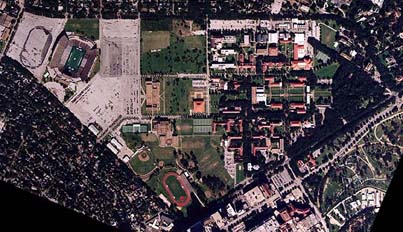|
|
| Exciting Real World Applications |
Power of Steam
|
|
 One of the more exciting applications of image processing these days
is the ability to bring out minute details in photos taken from very
far away. With the hunt for Usama Bin Laden well underway, everyone
loves looking at the spy photographs taken by either planes flying
at astounding altitudes or even satelites. The practices which
allow us to make out details in these photographs can be the same
procedures used in bringing out detail in our car, particularly
either sharpening
or edge
detection.
One of the more exciting applications of image processing these days
is the ability to bring out minute details in photos taken from very
far away. With the hunt for Usama Bin Laden well underway, everyone
loves looking at the spy photographs taken by either planes flying
at astounding altitudes or even satelites. The practices which
allow us to make out details in these photographs can be the same
procedures used in bringing out detail in our car, particularly
either sharpening
or edge
detection.
Given this aerial photo of Rice University, we could look at all
kinds of things. For instance, where we interested in the layout of
the campus and surrounding streets more than the actual look of the
campus from above, knocking out the lower frequencies and
normalizing the image would serve to bring out sharp contrast such
as the edges of buildings and streets. Were we to add these edges
to the origional image, we would have a sharper
image of the campus. When this is done right the resulting image appears to have been
taken that way in the first place, and you can't tell that someone
has altered it.
 Another real world application of working with images in the frequency
domain is in compression. Put ridiculously simply, in lossy compression you throw
away part of an image in order to make the file smaller. Commonly
used lossy compression algorithms are jpeg, mpeg, and the currenly
popular mp3 (mpeg layer 3). When you are "throwing away" part of any file in order to concerve space, it is important to know what you can
throw away without noticbly effecting the quality of that file. In
image compression, looking at the frequency domain characteristics of
the image can be extremly useful. For instance, were we to take a
look at the magnitude of the frequency content of this picture of
Scott Baio, childhood idol/ star of the wildly succesful 80's sitcom
Charles in Charge, we would likely see that the majority of the
content is at a fairly low frequency, this is the case in most images,
thus we are able to filter out the higher frequecys, often thought
of as smoothing the
image, decreasing the overall size of the file without greatly
affecting the percieved image.
Another real world application of working with images in the frequency
domain is in compression. Put ridiculously simply, in lossy compression you throw
away part of an image in order to make the file smaller. Commonly
used lossy compression algorithms are jpeg, mpeg, and the currenly
popular mp3 (mpeg layer 3). When you are "throwing away" part of any file in order to concerve space, it is important to know what you can
throw away without noticbly effecting the quality of that file. In
image compression, looking at the frequency domain characteristics of
the image can be extremly useful. For instance, were we to take a
look at the magnitude of the frequency content of this picture of
Scott Baio, childhood idol/ star of the wildly succesful 80's sitcom
Charles in Charge, we would likely see that the majority of the
content is at a fairly low frequency, this is the case in most images,
thus we are able to filter out the higher frequecys, often thought
of as smoothing the
image, decreasing the overall size of the file without greatly
affecting the percieved image.
|

 One of the more exciting applications of image processing these days
is the ability to bring out minute details in photos taken from very
far away. With the hunt for Usama Bin Laden well underway, everyone
loves looking at the spy photographs taken by either planes flying
at astounding altitudes or even satelites. The practices which
allow us to make out details in these photographs can be the same
procedures used in bringing out detail in our car, particularly
either
One of the more exciting applications of image processing these days
is the ability to bring out minute details in photos taken from very
far away. With the hunt for Usama Bin Laden well underway, everyone
loves looking at the spy photographs taken by either planes flying
at astounding altitudes or even satelites. The practices which
allow us to make out details in these photographs can be the same
procedures used in bringing out detail in our car, particularly
either  Another real world application of working with images in the frequency
domain is in compression. Put ridiculously simply, in lossy compression you throw
away part of an image in order to make the file smaller. Commonly
used lossy compression algorithms are jpeg, mpeg, and the currenly
popular mp3 (mpeg layer 3). When you are "throwing away" part of any file in order to concerve space, it is important to know what you can
throw away without noticbly effecting the quality of that file. In
image compression, looking at the frequency domain characteristics of
the image can be extremly useful. For instance, were we to take a
look at the magnitude of the frequency content of this picture of
Scott Baio, childhood idol/ star of the wildly succesful 80's sitcom
Charles in Charge, we would likely see that the majority of the
content is at a fairly low frequency, this is the case in most images,
thus we are able to filter out the higher frequecys, often thought
of as
Another real world application of working with images in the frequency
domain is in compression. Put ridiculously simply, in lossy compression you throw
away part of an image in order to make the file smaller. Commonly
used lossy compression algorithms are jpeg, mpeg, and the currenly
popular mp3 (mpeg layer 3). When you are "throwing away" part of any file in order to concerve space, it is important to know what you can
throw away without noticbly effecting the quality of that file. In
image compression, looking at the frequency domain characteristics of
the image can be extremly useful. For instance, were we to take a
look at the magnitude of the frequency content of this picture of
Scott Baio, childhood idol/ star of the wildly succesful 80's sitcom
Charles in Charge, we would likely see that the majority of the
content is at a fairly low frequency, this is the case in most images,
thus we are able to filter out the higher frequecys, often thought
of as